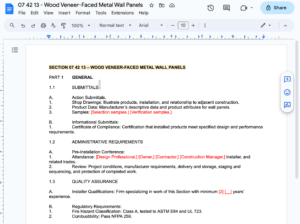For years we’ve seen sustainable project requirements with massive amounts of credits in each specification section for building products, and some say it’s gotten out of hand.
The last project I reviewed for a building product manufacturer had 2 pages of credit requirements in green font to review. It was interesting to find out that no manufacturer in that industry offered half of the credits. When thinking about sustainability, I wonder how many pages of extra paper will be required to print the project manual, specification sections, and submittals?
When talking with other specifiers about the latest sustainability system, I usually get a question on how our team is specifying sustainability design requirements. More specifically, what logic does SimpleSpecs use to specify sustainable requirements like LEED and other green systems?
It is relatively simple, but we find that sustainability has become difficult for a few reasons. In the end, it’s become more of a scavenger hunt for the contractor. But let’s break down how our team looks at sustainable project requirements.
LEEDv3
First, what’s changed in LEED to allow us to simplify our specifications?
Under v3, it was necessary to include provisions in each specification section throughout Divisions 02 through 50 that spelled out what was required for each product as far as sustainability was concerned. For example, under 05 50 00 – Metal Fabrications, we might include statements that steel must contain a minimum of 75 percent recycled content. And that it be sourced within 500 miles of the project site, depending on which LEED points we were pursuing.
Unfortunately, this could build in a potential conflict, as steel might be available with the required recycled content but not within 500 miles. As a result, you never quite knew which points you might achieve until a project estimate is completed.
It was hard to write specifications – derived from the word “specific” – when so little was known at the time the project manual was written.
LEEDv4
Fortunately, v4 changed all that with a completely different approach to products. For example, instead of stating that you want a certain product to have an Environmental Product Declaration (EPD), v4 states that you can achieve points by using “A…at least 20 different permanently installed products sourced from at least five other manufacturers…” that have EPD’s.
As a result of LEED v4, we have removed the vast majority of sustainability statements from sections in Divisions 02 through 50. Sections covering sustainability in Division 01, where they are applicable to all other Divisions. And the current LEED version, now govern sustainability requirements.
Keep in mind that these provisions apply to LEED projects. Other sustainable project rating systems, including Living Building Challenge, Collaborative for High Performance Schools, and local or state programs, may dictate another approach.
Sustainable Project Requirements
In SimpleSpecs™ our logic is to specify sustainability requirements in Division 01. Our team specifies sustainability requirements in one location and avoids identifying each credit in every specification section. Saying it once and only once in the most logical place. Here are guide specifications we’ve developed for SimpleSpecs users:
LEEDv4
01 81 13 Sustainable Project Requirements
01 81 13 Sustainable Project Requirements for Design/ Build projects


